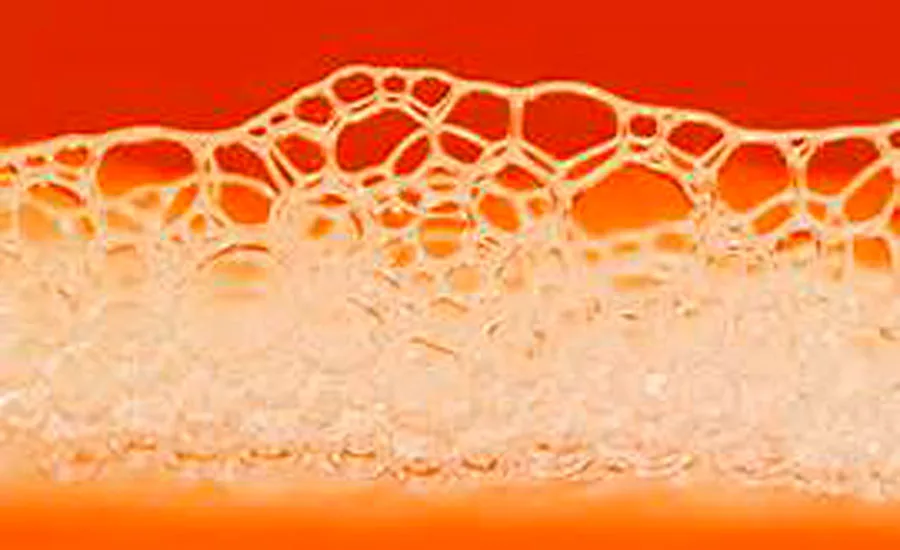What are Defoamers?

Note: This article originally appeared at http://knowledge.ulprospector.com/5058/pc-defoamers-an-introduction/.
Defoamers are chemical additives that reduce and/or prevent the formation of foam in industrial process liquids such as paints, inks, adhesives and even construction products. The terms antifoam agent and defoamer are often used interchangeably, however, antifoam agents more accurately refer to materials that inhibit the generation and formation of bubbles. Dependent upon the application and performance requirements, they consist of polydimethylsiloxanes and other silicones, insoluble oils, stearates and glycols, as well as inorganics, such as silicates and talc.
What is Foam?
Foam is a coarse dispersion of a gas in a liquid, where the volume fraction of gas is greater than that of the liquid. The bubbles will migrate to the surface, as their density is less than that of the liquid. As the bubbles coalesce and collect at the air/surface interface, the bubble walls thin and break. Defoamers accelerate the process and break the smaller bubbles as well. Generally a defoamer is insoluble in the foaming medium and has surface-active properties. An essential feature of a defoamer is the ability to spread rapidly on foamy surfaces.
In industrial processes, foams pose serious problems. They cause defects on surface coatings. They prevent the efficient filling of containers. Some of the sources of foam formation include:
- Inclusion of air through agitation during production, filling, mixing of two-pack systems (often high-viscosity (epoxies, adhesives);
- Air inclusion on the pigment surface, resulting in poor wetting of pigments;
- Application: roller, spraying, brushing;
- Filtration through sieve or anything with air on the surface;
- Generation/liberation of gases during chemical curing processes; e.g. polyisocyanates;
- Introduction of air through substrate wetting (wood coatings, other highly porous substrates).
It is suggested that the following is considered if you require a more thorough understanding of the subject of foam generation, defoamer composition, mechanisms, etc.:
- Foam stabilization
- Composition and mode of action of defoamers
- Test methods
- Paints
- Inks
- Adhesives
- Construction products
- Selection guidelines
- Process
- Application
- Coatings defects
Dissipating Foam
For this article, the focus will be on the mechanical dissipation of foam as well as the chemical elimination of foam. In the former, there are several effective methods: 1) bubble consolidation is achieved with lower shear mixing, which will put the microfoam in contact, esp. at the surface (vortex), and foam will consolidate to larger bubbles that break more easily; 2) vibration using a rotosieve to reduce the surface tension at the air/liquid interface in processes such as filtration of latexes; 3) utilizing a very fine mist of water spray - the bubble walls will be disrupted and break; 4) vacuum such as a RotoVap or Ross Mill homogenizer and vacuum.
Chemical defoamers similarly have analogous methods, which are in the form of composition rather than processes: 1) in process, they can either consolidate small foam to larger bubbles, which can then break at the air/liquid interface; and 2) break bubbles during mixing and shear. During application, they: 3) disrupt the bubble wall, or cause increased drainage. In many cases, the choice of a chemical defoamer is a balance between highest efficiency and lowest undesired side effects, coupled with a preferred mechanical process, if available.
Choosing the Right Defoamer and Test Method
There are many considerations in the choice of a defoamer. For paints, persistency over a long shelf life is required, but the defoamer (often mineral-oil based) cannot affect color uniformity, such as rub-up. For waterborne flexographic inks, mineral oil is not a consideration as it causes roller and plate swelling. Therefore, the preferred defoamers are based on glycols and polyglycol (ethers). Silicone defoamers are used in solventborne and high-viscosity systems, and are used more in the grind stage of pigment dispersion, rather than in the letdown.
Choosing the correct test method that includes the appropriate substrate and perseverance upon storage is key. As an example, if formulating a waterborne polyurethane or acrylic urethane, a strong defoamer may be required, since application to a porous wood substrate will liberate microfoam, and the coating surface energy is particularly high. If a film is cast over a sealed paper chart such as a Leneta 2C card, the film may show severe crawling and fisheyes. The conclusion might be that there was an overdose of defoamer. However, testing on a Leneta R1A Birch plywood plank would show a uniform coating void of film defects and bubbles. Heat aging is a quick way to evaluate long-term storage stability, usually done at intervals of one week for a total of four at 50 °C; testing at each week. The other critical test is compatibility to ensure that the defoamer doesn’t interact or react with a component of the coating and cause seeding.
Conclusion
In summary, defoamers are essential ingredients in a paint formulation avoiding foam formation and stabilization in waterborne as well as solventborne paints. Proper selection of defoamer quality and quantity is essential for optimal defoamer performance. Defoamers compete with foam-stabilizing ingredients in order to be effective in a coating system. The proper defoaming results in paint quality properties, and it is important that test methodologies are appropriate for the specific application or process.
1 Quantitative Performance Assessment of New Foam Control Agents in Waterborne Coatings, Ashland Specialty Ingredients 3/25/2013.
2 Axalta Coating System, Paint Defects Manual 9/12/2013.
About Prospector® from UL
Prospector is a specialized material and ingredient search engine for product developers offered by UL, the world leader in product safety. The Prospector Knowledge Center publishes articles on materials, processes, technical challenges and more from top industry experts. For more information, visit https://www.ulprospector.com.
By Marc Hirsch, Senior Development Scientist, M&M Hirsch & Associates, LLC, Roanoke, VA. Originally published on the Prospector® website, http://knowledge.ulprospector.com/

Looking for a reprint of this article?
From high-res PDFs to custom plaques, order your copy today!





